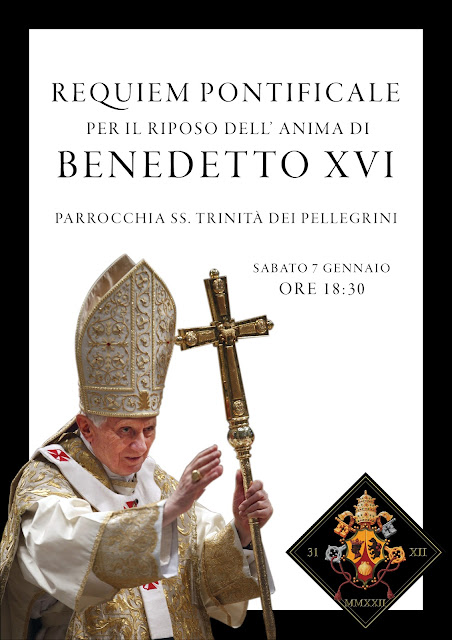 |
| Catafalque at Santissima Trinita' dei Pellegrini, Rome. |
 |
| Catafalque at San Nicola in Carcere, Rome. |
The absolution prayers are prayed at the catafalque after the funeral Mass and before the final recessional. This extra lesson in reverence teaches us to honor the dead as their bodies are temples of the Holy Spirit, tabernacles of Christ, and worthy instruments used in His service and destined to rise again at the time of the final judgment. Below are several images of the catafalque that was set up at FSSP in Urbe, the FSSP parish in Rome, for their Requiem Mass for the soul of Benedict XVI last Saturday.
Inscribed on two sides of the catafalque, to mark the solemnity of the occasion, are these poetic commendatory inscriptions, written in Latin as a funeral oration to the memory of the deceased Pontiff. The deed commemorates especially Benedict XVI's incredible contribution to the cultivation of sacred liturgy.
BENEDICTI XVI P. M. AVCTORITATEAD X. KAL. APR. AN. SAL. MMVIII DIE RESVRRECTIONIS DOMINICÆPER DECRETVM VICARII VRBIS CAMILLI S.R.E. PRESB. CARD. RVINIS. PHILIPPI NERII OLIM. EXTRVCTVM IN PARŒCIAM CVM CVRA FIDELIVMPRISCIS RITIBVS LITVRGICIS ADHÆRENTIVM SVB TITVLOSS. TRINITATIS PEREGRINORVM AD MAIOREM DEI GLORIAM ERECTVM EST
***ÆTERNÆ MEMORIÆBENEDICTI XVI PONTIFICIS MAXIMIMODERATORIS DE SACRA LITVRGIA SOLLICITI QVI NON IVL. AN. SAL. MMVIILITTERIS APOSTOLICIS MOTV PROPRIO DATIS SVMMORVM PONTIFICVMVT DEBITA REVERENTIA ERGA DIVINVM CVLTVM DENVO INSTAVRARETVRSACRA MYSTERIA IVXTA ANTECEDENTES MAIORVM VSVS SERVANDA DECREVITPAROCHVS ET FIDELES HOC GRATI ANIMI MONVMENTVM RELIQVERVNT
Translation by Gregory diPippo:
To the everlasting memory of Pope Benedict XVI, a judicious moderator of the sacred liturgy, who on July 7, in the Year of Salvation 2007, by the Apostolic Letter given Motu Proprio, titled Summorum Pontificum, decreed that the sacred mysteries were to be kept according to the prior customs of our forefathers, so that due reverence for the worship of God might again be restored. The parish priest and faithful have left this monument as a witness of their gratitude.
By the authority of Pope Benedict XVI, on March 23, in the Year of Salvation 2008, on the day of the Lord's Resurrection, by decree of the Vicar of the City Camillo Cardinal Ruini, the church formerly built by the effort and piety of St. Philip Neri to receive pilgrims was erected as parish with care of the faithful who are attached to earlier liturgical rites, under the title of the Most Holy Trinity of the Pilgrims, for the greater glory of God.



























